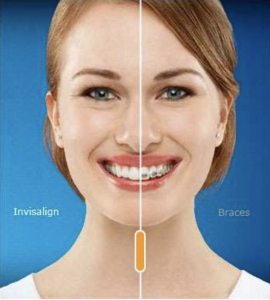
Today’s world focuses on the aesthetics of an individual and considers this element as important as any other aspect of our personality. Hence, individuals want to look good even when they are undergoing orthodontic treatment. Metallic braces don’t look pleasant when you are a person who needs to give public appearance most hours of the day. Lingual braces and Invisalign are two techniques through which the orthodontic treatment can be carried out in an obscured way.
This means that you look beautiful in your pursuit of achieving beautiful looks.

Lingual braces, as the name suggests, are braces that are worn on the inner surfaces of the teeth that face the tongue. The desired tooth movement is achieved by fixing the braces on the inner side if the teeth. Invisalign, on the other hand, are virtually invisible aligners as they are fabricated from plastic material and are created on the basis of a set of radiographs and impressions. They need to be worn for at least twenty hours a day for few months. Each pair of aligners should be worn for a period of two weeks and then another pair of aligners is given to the patient. The success of the treatment through Invisalign depends on how long the individual wears the aligners. As they are removable, the dentist can just advise the patient to wear the aligners but cannot control the time period for which it is worn.

Each type of braces comes with its own set of pros and cons. Every case is different from another. Hence, your dentist is the best person to guide you in the type of braces that is the most suitable option for you.
Lingual Braces Pros and Cons
THE PROS
Esthetic· The lingual braces are obscured from vision as they are attached to the lingual surfaces. · The close friends and even the family members of the wearer cannot make out if the braces are present or not until and unless the wearer reveals it to them. |
Better Control· As these braces are fixed through metal brackets and archwires, the dentist can control the entire treatment procedure. · Hence, a wide range of malalignments can be treated through lingual braces. |
Fixed· As the braces are attached to the teeth, the wearer cannot remove them at will. · This affects the course of treatment positively as the treatment can be completed within the expected time period. · This may not be the same in case of Invisalign as the treatment time depends solely on the diligence of the wearer. |
THE CONS
Discomfort· The tongue is the most affected organ in case of lingual braces. · Every time the wearer moves the tongue, it touches the braces. · This can lead to some amount of soreness and discomfort. · Some individuals experience difficulty in speech due to tongue interferences.
|
Tough Maintenance· Maintenance of oral hygiene is extremely difficult with lingual braces as they are not easily accessible to cleaning aids. · The wires and brackets serve a great spot for the food particles to get stuck into. · Removal of the food remnants is a mammoth task as it demands impeccable dexterity.
|
| High level expertise
· Fixing of lingual braces demands high level of expertise. · The materials used differ from the conventional braces and add up to the cost of the treatment. · Some lingual surfaces have a different shape and form and require customization of braces. · All these factors raise the charges for the orthodontic treatment. |
Do Lingual Braces Take Longer
In the first appointment, the dentist records the impressions of the patient and sends it to the laboratory so that a model is prepared. On this model, the dentist bends the wires and keeps it prepared for the next appointment. Now the braces are fixed onto the lingual surface through dental cement. Just like the conventional braces, the patient is called once in a month for review. The duration of treatment through lingual braces is similar to the time period taken in case of conventional braces. The duration may be longer depending on the severity of the case. Usually, the time taken is close to about one and a half years. If the crowding of teeth is more or if there are multiple defects in alignments that need to be corrected, there are chances for the treatment to extend for another year.
